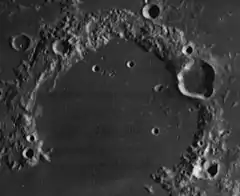Russell (lunar crater)
Russell is the lava-flooded remains of a lunar impact crater. It is located in the western part of the Oceanus Procellarum, close to the western lunar limb. As a result, it appears oblong-shaped due to foreshortening.
 Lunar Orbiter 4 image | |
| Coordinates | 26.5°N 75.4°W |
|---|---|
| Diameter | 103 km |
| Depth | None |
| Colongitude | 78° at sunrise |
| Eponym | Henry Norris Russell John Russell |
The south-southwestern rim of Russell overlaps the larger rim of the lava-flooded crater Struve, and together the two crater rims form a figure-8 outline with a wide gap where they are joined. To the east of Russell is Briggs, and to the southeast, adjacent to Struve, is the lava-flooded remains of a crater called Eddington.
The rim of Russell is heavily worn and irregular in form, with multiple crater impacts overlying the wall. The largest of these is Briggs A on the eastern rim. To the north of Russell are the flooded remnants of several smaller craters. Russell's lava-flooded floor is flat and level with the surrounding mare. It lacks a central peak.
In the past this crater was sometimes designated as Otto Struve A, or just assumed to be part of the larger Struve. The crater Eddington to the southeast has also been designated as Otto Struve A on old lunar maps.
Satellite craters
By convention these features are identified on lunar maps by placing the letter on the side of the crater midpoint that is closest to Russell.
| Russell | Latitude | Longitude | Diameter |
|---|---|---|---|
| B | 26.4° N | 78.2° W | 19 km |
| E | 28.6° N | 74.5° W | 9 km |
| F | 28.0° N | 76.4° W | 9 km |
| R | 28.7° N | 75.3° W | 45 km |
| S | 29.4° N | 77.1° W | 25 km |
See also
- 1762 Russell, asteroid
- Russell (Martian crater)
References
- Andersson, L. E.; Whitaker, E. A. (1982). NASA Catalogue of Lunar Nomenclature. NASA RP-1097.
- Blue, Jennifer (July 25, 2007). "Gazetteer of Planetary Nomenclature". USGS. Retrieved 2007-08-05.
- Bussey, B.; Spudis, P. (2004). The Clementine Atlas of the Moon. New York: Cambridge University Press. ISBN 978-0-521-81528-4.
- Cocks, Elijah E.; Cocks, Josiah C. (1995). Who's Who on the Moon: A Biographical Dictionary of Lunar Nomenclature. Tudor Publishers. ISBN 978-0-936389-27-1.
- McDowell, Jonathan (July 15, 2007). "Lunar Nomenclature". Jonathan's Space Report. Retrieved 2007-10-24.
- Menzel, D. H.; Minnaert, M.; Levin, B.; Dollfus, A.; Bell, B. (1971). "Report on Lunar Nomenclature by the Working Group of Commission 17 of the IAU". Space Science Reviews. 12 (2): 136–186. Bibcode:1971SSRv...12..136M. doi:10.1007/BF00171763. S2CID 122125855.
- Moore, Patrick (2001). On the Moon. Sterling Publishing Co. ISBN 978-0-304-35469-6.
- Price, Fred W. (1988). The Moon Observer's Handbook. Cambridge University Press. ISBN 978-0-521-33500-3.
- Rükl, Antonín (1990). Atlas of the Moon. Kalmbach Books. ISBN 978-0-913135-17-4.
- Webb, Rev. T. W. (1962). Celestial Objects for Common Telescopes (6th revised ed.). Dover. ISBN 978-0-486-20917-3.
- Whitaker, Ewen A. (1999). Mapping and Naming the Moon. Cambridge University Press. ISBN 978-0-521-62248-6.
- Wlasuk, Peter T. (2000). Observing the Moon. Springer. ISBN 978-1-85233-193-1.